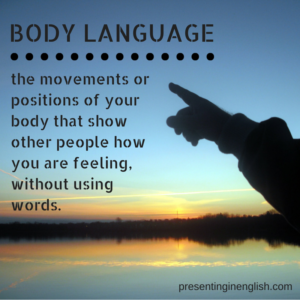
BODY LANGUAGE: the movements or positions of your body that show other people how you are feeling, without using words. – Cambridge Advanced Learners Dictionary & Thesaurus
Our body can communicate a lot of things even if you are not speaking. It gives away that you are nervous with shaking hands or a rigid posture. It lets the audience know you are happy to be there with a smile. It shows you are relaxed with open arms.
Body language can be voluntary or involuntary. Through practice it becomes easier to use voluntary body language such as gestures to communicate your message and stop involuntary signs of nervousness.
Movement as small as eye contact and as large as movement across the stage and everything in between is considered body language. As speakers our goal is to have our body communicate the same message as our words.
Here are some strategies you can use to improve your body language.
- Watch a video of your presentation. This is the quickest way to find out what involuntary body language you using and what you may want to stop doing.
- Focus on one element of body language that you want to improve, such as eye contact. Then for your next few presentations focus on having good eye contact. After you feel you have improved, then choose another element of body language you want to improve.
- Make your body language match what you are saying. For example, if you have three points to make you can show that visually to the audience by counting on your fingers as you go through your points.
- Don’t pace back and forth on the stage. Move with purpose. If you are changing sections in your speech, change where you are standing.
- If you are writing out an important part of your speech try include notes about your body language. This can be as simple as point to the screen or as detailed as move to the left, raise right arm and make a fist. This way with repeated practice your body will reflect exactly what you want to communicate.
